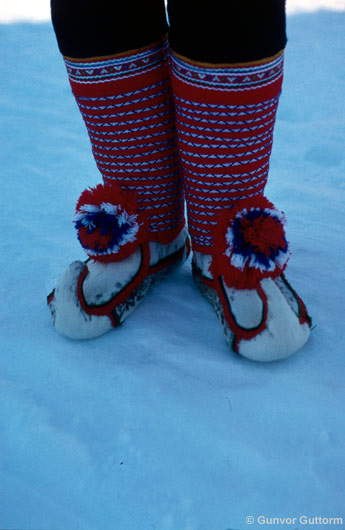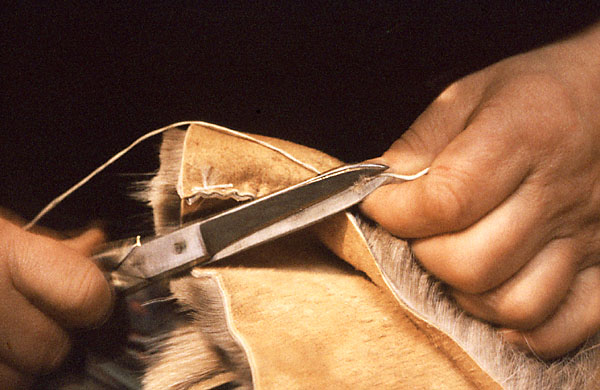The leg skin of the reindeer
Gámas
The leg skin of the reindeer
The word gámas tells that it is raw material. Gámasgottur means the skin of all four legs of a reindeer. These leg skins can be taken from a reindeer slaughtered in the period from autumn to spring, depending on what they are going to be used for. It is the length and the thickness of the fur that decide that. In order to make boots for special occasions leg skins with short hair are chosen. The colours of the leg skins should be evenly white, dark brown or spotted. For daily footwear, leg skins with longer hair are used and then leg skins could be taken from a reindeer of yellowish grey colour. The leg skins taken in the autumn have short hair but the skin itself is thick. The leg skins are dried in different ways and made softer with the scraper. The skin part of the leg skin is tanned by smearing boiled bark on them. For one pair of reindeer boots, nuvttohat or goikkehat, the leg skins of one reindeer are used (gámasgottur). Goikket or nuvttot are words describing winter footwear. Vuottagáma tells that the footwear needs shoe brogue-bands/vuoddagat. The pattern of the woven or plaited shoe bands tells of origin as well as the shape of the shoe/boot. Deattaláđđegáma are boots decorated with broadcloth. Seahkohat are boots with side-pieces all the way to the curved tip. If we look at old sources like Schefferus, we get the impression that all Saami boots looked like that in the 17th-18th century. Guretgápmagat have lacing, so there is no need for shoe bands. Gállohat are boots made from the skin of the head of the reindeer. There are a number of ways of sewing reindeer boots. In the North Saami areas the leg skin is folded neatly and stitched to the tip of the boot inside out, which results in a sharply bent tip. In the Julev and South areas the leg skin is folded on the hairy side and the tip becomes straighter.
For making gálssohat/reindeer trousers or leggings the skins of the legs of two reindeer are needed. Dark brown autumn leg skins with short hair make the nicest gálssohat, long hair leg skins are used for sewing working gálssohat. Stihkágálssohat are trousers of leg skins with the upper part made of tanned hide. Here, again, the decoration of broadcloth in different colours and patterns indicate the origin of the stihkágálssohat. It is also possible to tell from which area the wearer comes by looking at the way he has tied his shoe bands to the end of his gálssohat.
For making gistát/mittens the leg skins of one reindeer are needed. The choice of what kind of leg skins is determined by the usage of the mittens. If they are for dressing up, autumn leg skins with short hair in the colour of dark brown or white can be chosen. For every day working mittens leg skins with longer hair and of mixed colour are more appropriate. The mittens can be decorated with broadcloth and other ribbons.
Duodji: tools, materials etc..
Table of contents: Living and household, clothing etc.

